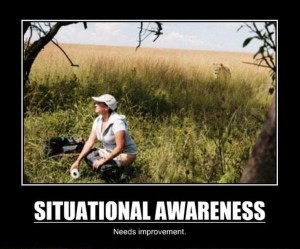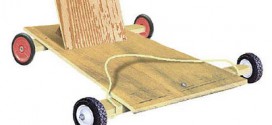 I fear sometimes that I will end up sounding like some old guy yelling at kids to “Get Off My Lawn!” when I write opinion pieces like this, but sometimes I just can’t help myself.
I fear sometimes that I will end up sounding like some old guy yelling at kids to “Get Off My Lawn!” when I write opinion pieces like this, but sometimes I just can’t help myself.
For example, in 2008, I wrote an article called “Spots In My Eyes & Ringing In My Ears” which was a rant about the lack of manners people have when using electronic devices. I was frustrated by several specific events of out-right rudeness on the part of people more involved with their cell-phones and iPods than their environment. The funny thing about that article was how much attention it has gotten over the years from internet users but for all the wrong reasons.
When I look at the analytics for this website, I see a lot of people finding this article because they using search terms like “seeing spots” or “hearing ringing.” I can only hope that they take the time to read the piece before moving on to continue searching for their potential medical cure. Even though I didn’t know it was called “situational awareness” at the time, I think it was my first attempt at applying situational awareness to everyday life.
Many professions including the military, medical field, first responders and police departments stress situational awareness to their members. Strategic Forecasting, Inc., more commonly known as Stratfor, is a global intelligence company founded in 1996 in Austin, Texas that publishes daily strategic intelligence briefings used by Fortune 500 companies and government agencies around the world. Their briefings often reference situational awareness specifically in relation to criminal and terrorist attacks. Briefings like this one and even this Primer On Situational Awareness.
Granted, Strafor’s references to situational awareness tend to focus on threats to personal or national security, but they make a couple of great points in the Primer:
First and foremost, it needs to be noted that being aware of one’s surroundings and identifying potential threats and dangerous situations is more of a mindset than a hard skill. Because of this, situational awareness is not something that can be practiced only by highly trained government agents or specialized corporate security counter-surveillance teams. Indeed, it can be exercised by anyone with the will and the discipline to do so. Read more: A Primer on Situational Awareness | Stratfor
So, situational awareness is not a skill it is a mindset of being aware of your surrounding. And, it is something anyone can do. Not only that, but Stratfor defines five levels of awareness “tuned out;” “relaxed awareness;” “focused awareness;” “high alert” and “comatose.”
- Tuned Out – The state of awareness of most people.
- Relaxed Awareness – Similar to the state people are in when they are driving defensively
- Focused Awareness – A heightened awareness state similar to driving in hazardous conditions.
- High Alert – This state usually involves an adrenaline rush, a gasp of air and prayer all at the same time. A car pulling out in front of you or failing to stop at a stop sign can induce this state.
- Comatose – This is when you are so scared you are frozen and cannot act or respond.
Clearly the state we should all be in is Relaxed Awareness, but unfortunately, most people live their lives Tuned Out.
The Coast Guard has published a program called Team Coordination Training (TCT) that focuses on reducing the probability for human error by increasing individual and team effectiveness. Chapter 5 of this course deals solely with Situational Awareness as it applies to the safety of the team. On the first page of this chapter, the Coast Guard defines Situational Awareness as:
Situational Awareness is the ability to identify, process, and comprehend the critical elements of information about what is happening to the team with regards to the mission. More simply, it’s knowing what is going on around you.
The emphasis is theirs not mine, but if they had not emphasized it, I would have. Situational Awareness at its most basic level is KNOWING WHAT IS GOING ON AROUND YOU! The Coast Guard points out that the success of the team is dependent upon every member of the team maintaining situational awareness when the team is in action.
There is a website called “Situational Awareness Matters” which focuses on the idea of situational awareness as it applied to first responders. The tagline on the website is “Helping responders see the bad things coming in time to change the outcome.” It’s really not about trying to see the future, but rather anticipating the bad outcomes and working pro-actively to avoid those outcomes.
I think a good working definition of Situational Awareness goes something like this: Knowing what is going on around you and proactively influencing the situation in a positive way. Now that we are all on the same page about the concept of Situational Awareness, I’ll proceed with my rant. 🙂
Recently, my wife and I stopped at the local Sam’s Club to fill up with gas and there was a line, so we had to wait. There were several lines with two pumps on each side. We chose a line and there were three cars in front of us. Car A was at pump #1, Car B was at pump #2 , Car C was the first in line behind Car B and we were behind Car C. The drivers of Cars A & B finished pumping gas and they both pulled out at the same time. Car C then begins to move forward and the driver decides to stop at pump #2 instead of pulling all the way up to pump #1. While I sat behind the wheel, with my jaw dropping, the exact same thing happened on the lane next to us. Because I assumed that Car C was going to pull all the way through to pump #1, I was too close to Car C and I had to back up and then pull around Car C and try to line up with pump #1, so I could get gas. That was better than what happened in the other lane, because someone further back in the line saw what was going on and jumped ahead and stole the open pump from the person who had been in front of them.
All of the frustration I was feeling and what the driver who was cut off was probably feeling as well, was a direct result of the lack of situational awareness of people who were more focused on getting what they wanted than on being aware of what was going on around them. Had they simply noted that the line was long and that both pumps were clear, they would have simply pulled all the way forward to pump #1 leaving pump #2 open for the person behind them. Ironically, this simple act would have been perceived as common courtesy even though courtesy didn’t have to enter their mind in order to make the correct decision.
When someone turns left from the right hand lane or cuts someone off in traffic, they are clearly displaying a lack of situational awareness. When I was taking Drivers Ed in high school, our teacher taught us the concept of driving defensively which involved paying attention to eight points on the car you are driving. We were instructed to pay attention to what was in front of us, what was behind us, what was on the left, what was on the left and what was on the four corners of the car. As well as all of this, we were expected to look ahead to pay attention to what was developing in front of us so we could react to whatever we were approaching.
A great example of this occurred to me back in 1989 when I was traveling to Meridian, MS for to interview for the job that would eventually bring me to Meridian permanently. I was heading East on I-20 and when I reached the point just outside of Meridian where I-59 North merged with I-20, I noticed a pickup truck traveling North on I-59 at a high rate of speed. The truck passed me just at the junction and sped ahead of me as I backed off my accelerator. My car slowed a bit and the truck shot forward increasing the distance between us to about half a mile.
Suddenly, the truck hit a bump in the road and the rear bumper of the pickup fell off the truck and began sliding along the Interstate. I was of course surprised by the bumper falling off, but then I quickly realized that as the bumper slowed, I was gaining on it rapidly. I needed to make a decision rather quickly to either stay in the lane I was in or move to the left hand lane. As soon as the bumper fell off, I had taken my foot off the gas so I was slowing down as well, but not as quickly as the bumper. I checked my mirror and made sure no one was behind me and then checked my left and made sure no one was on my left. Next, I assessed the direction of the bumper which appeared to be sliding straight along the same lane, so I moved to the left hand lane, hit the gas and safely passed the bumper before it had come to a complete stop. Fortunately, the pickup had stopped and the driver was heading back to get his bumper.
Now, let’s review this again, but assume I had been playing with the radio. Those few seconds of time that I had to check behind me and to my left would have been gone. In fact, I may not have even seen the bumper before I hit it. We didn’t have cellphones to text with back then, but had this happened today to a driver who was texting and driving, the outcome could have been deadly.
But Situational Awareness is not just something we should be doing just while driving. I’m convinced that we should all be situationally aware at all time. Not just because being aware keeps us safe, but because being aware makes us better humans.
When was the last time you noticed a harried mother with a two year old about to throw a tantrum in the line behind you at the grocery store? Did you take a moment to be ‘aware’ of her situation and did you consider letting her go ahead of you in order to make her day a little better? If you did, I bet it made your day better too.
When was the last time you were talking with a friend and you noticed something in their voice that made you aware that something was wrong? Were you able to spend a few more minutes with that person and offer your shoulder for them to lean on?
When was the last time you were at work and you noticed something out of the ordinary with the books and decided to dig a little bit just to make sure everything was correct? It wasn’t your money, or your books, but you might have saved your job by protecting the company.
Situational Awareness should be taught at all levels of school and at all jobs. It can help employees give better service to customers and satisfied customers are repeat customers. Moreover, satisfied customers sing your praises and refer more people to you.
I’ll leave you with this last example from my own life. When I was a teenager, I worked part time at Fred’s Discount Store as a stock clerk and sometime cashier. One Saturday, a lady came through my line with about 30 cans of dog food in her buggy. I realized as I was ringing up all the cans that the paper bags we had would not hold up and that she really needed a cardboard box in which to haul all these cans. So, after we completed the sale, I asked her to wait for a moment and I ran to the back, found a box and filled it with her cans of dog food and she left happy as a lark. The next Saturday, the lady returned and I happened to be working in an area near the dog food aisle, so when I saw her, I went and got her a box for the cans. For the next two years, every Saturday this woman would come to Fred’s to buy 30 cans of dog food and every Saturday, I met her with a box. That works out to over 3,000 cans of dog food that Fred’s sold this woman because someone offered her a box that was going to be thrown away. Sadly, I never asked her for her name.
I think that being aware of what is going on around you is really just a means to an end. Learning to be aware can make you more courteous to the world around you and keep you safer at the same time. I’ll be the first to admit that I’m only learning how to be aware of my surrounding at all times and I still fail a lot. But as Stratfor points out, it is a state of mind rather than a skill and I believe that if I continue to try to be aware, it will become easier and easier going forward.
So, maybe I am becoming that old guy, but at least I’m trying not to yell.
Further Reading and Resources on Situational Awareness
- How to Develop the Situational Awareness of Jason Bourne
- “Toward a Theory of Situation Awareness” by Dr. Mica Endsley.
 GuruGraffiti Writing On The Walls Of The Internet
GuruGraffiti Writing On The Walls Of The Internet




